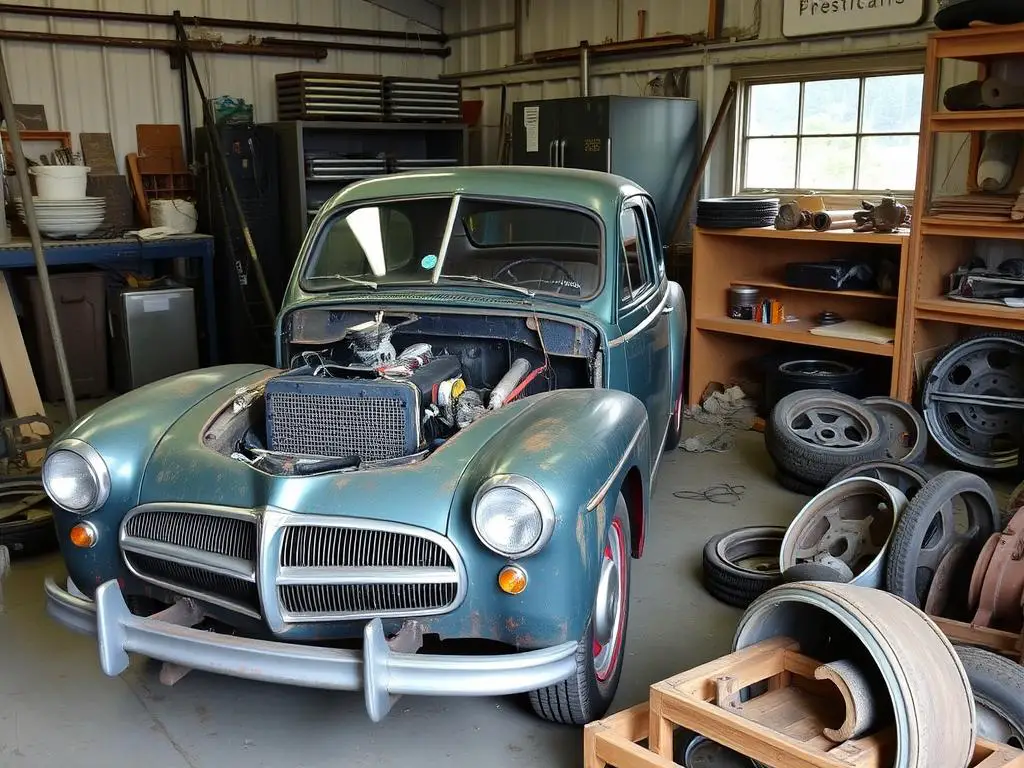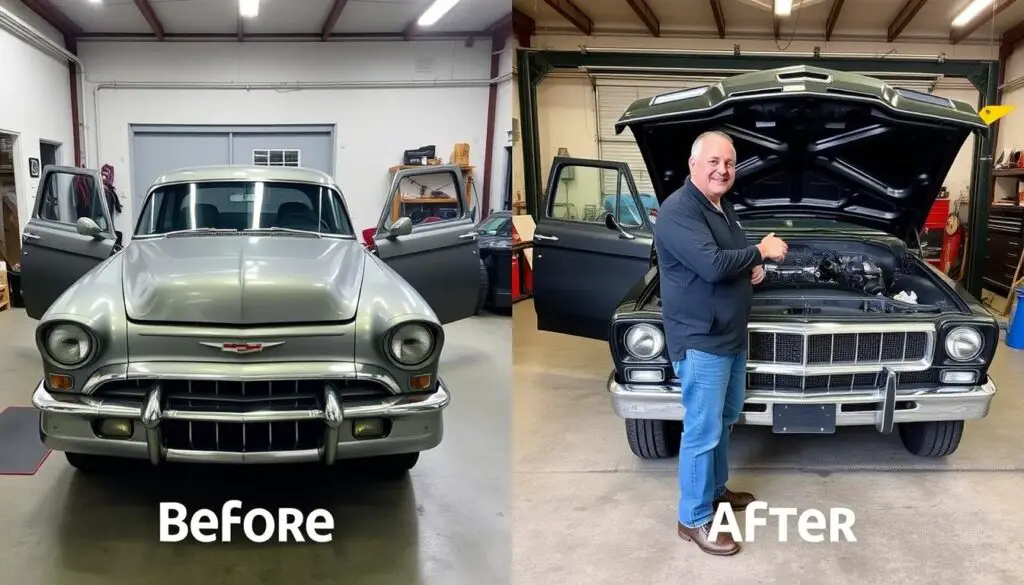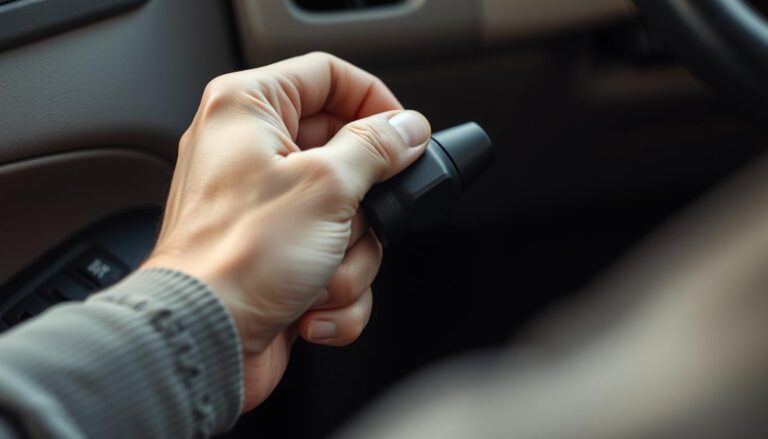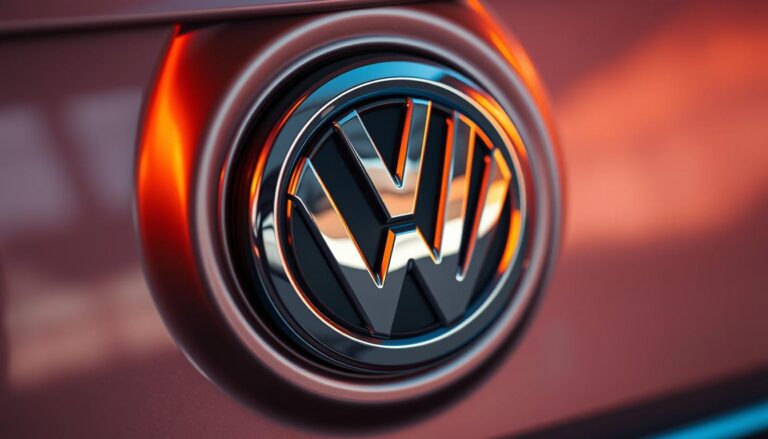When it comes to automotive overhaul costs, one question stands above all others: who’s responsible for footing the bill? Whether you’re restoring a classic car, repairing collision damage, or upgrading a daily driver, understanding financial responsibility is crucial before starting any major automotive project.
This comprehensive guide breaks down who pays in different scenarios, what factors influence payment responsibility, and how to protect yourself financially when undertaking significant vehicle modifications or restorations.
Understanding Automotive Overhauls and Their Costs
An automotive overhaul goes far beyond routine maintenance. These extensive projects involve significant disassembly, replacement of major components, and comprehensive restoration work that can transform a vehicle’s condition, performance, or appearance.
The average cost for major automotive overhauls ranges widely based on the project scope:
| Overhaul Type | Average Cost Range | Typical Timeframe |
| Engine Replacement/Rebuild | $5,000-$10,000+ | 1-3 weeks |
| Transmission Replacement | $3,000-$9,000 | 3-7 days |
| Complete Restoration | $15,000-$80,000+ | 3-12 months |
| Collision Repair | $3,000-$10,000+ | 1-4 weeks |
| Custom Modification | $5,000-$25,000+ | 2-8 weeks |
| EV Battery Replacement | $4,000-$18,000 | 1-3 days |
These figures represent national averages and can vary significantly based on vehicle make, model, age, parts availability, and your geographic location. Labor rates alone can range from $75 to $150 per hour depending on the shop’s specialization and region.
Common Automotive Overhaul Scenarios
Before determining who pays, it’s important to understand the different contexts in which major automotive work occurs. Each scenario comes with its own set of financial responsibilities and considerations.

Personal Restoration Projects
These are owner-initiated projects where enthusiasts restore vehicles for personal satisfaction, increased value, or improved performance. Examples include classic car restorations, engine swaps, or performance upgrades.
Professional Restoration Shops
Specialized businesses that handle comprehensive vehicle restorations, often for collector or vintage vehicles. These shops typically work on contract basis with detailed agreements about scope, costs, and payment schedules.
Insurance-Related Repairs
Major repairs resulting from accidents, natural disasters, or other covered incidents. These overhauls focus on returning the vehicle to its pre-damage condition rather than enhancement or modification.
Warranty Work
Significant repairs covered under manufacturer warranties, extended warranties, or service contracts. These typically address premature component failures or manufacturing defects.
Business/Commercial Vehicle Overhauls
Fleet vehicles or commercial equipment that require major repairs or refurbishment to extend service life or maintain operational status.
Who Bears Financial Responsibility?
Payment responsibility varies significantly based on the nature of the overhaul, existing agreements, and the parties involved. Here’s a detailed breakdown of who typically pays in each scenario:
Owner-Funded Personal Projects
For enthusiast-driven restorations and modifications, the vehicle owner typically bears 100% of the costs. These projects are discretionary investments rather than necessary repairs, so external funding is rarely available unless specifically arranged.
- All parts, labor, and specialty work costs fall to the owner
- Owners may need to budget for unexpected expenses as projects often exceed initial estimates
- Financing options like personal loans or specialty restoration loans may help spread costs
- Tax implications may apply if the vehicle appreciates significantly in value
Insurance Company Coverage
When overhauls result from covered incidents, insurance companies typically pay for repairs, minus any applicable deductibles. However, several factors affect coverage:
What Insurance Typically Covers:
- Collision damage repair to pre-accident condition
- Fire, theft, or natural disaster damage
- OEM parts (depending on policy specifics)
- Labor at prevailing market rates
What Insurance Typically Excludes:
- Pre-existing damage or wear
- Upgrades beyond original specifications
- Mechanical failures unrelated to covered incidents
- Customizations not declared on the policy
When insurance declares a vehicle a total loss (repairs cost more than the car is worth), they’ll pay the market value instead of covering repairs. If you disagree with their valuation, you can appeal with supporting documentation like recent service records or comparable vehicle listings.
Warranty Provider Responsibility
Manufacturer warranties, extended warranties, and service contracts can cover major overhauls if they fall within the covered components and time/mileage limitations:
- Factory warranties typically cover manufacturing defects and premature failures
- Extended warranties may cover major components like engines and transmissions beyond the factory warranty period
- Service contracts vary widely in coverage but can include major system overhauls
- Most warranties exclude damage from accidents, misuse, or improper maintenance
Shared Cost Arrangements
In some cases, costs may be divided between multiple parties:
- Goodwill repairs: Manufacturers sometimes cover partial costs for repairs outside warranty as a customer service gesture
- Split deductibles: Some insurance policies divide responsibility between parties in multi-vehicle incidents
- Service contracts with co-pays: Some extended warranties require the owner to pay a portion of repair costs
- Negotiated settlements: In disputed cases, parties may agree to share costs to avoid litigation
Business/Commercial Vehicle Considerations
For business-owned vehicles, different financial considerations apply:
- Tax-deductible business expenses for necessary repairs and maintenance
- Fleet maintenance contracts may cover major overhauls at predetermined rates
- Business insurance policies often have different coverage terms than personal policies
- Capital improvement considerations for significant upgrades that extend useful life
Factors That Influence Payment Responsibility
Several key factors determine who ultimately pays for automotive overhaul costs:
Contract Agreements
The most definitive factor in payment responsibility is any written agreement between parties. These contracts typically specify:
- Scope of work to be performed
- Payment terms, schedules, and methods
- Responsibility for unexpected costs or overruns
- Dispute resolution procedures
- Warranty terms for completed work
Insurance Policy Terms
Insurance coverage for overhauls depends entirely on policy specifics:
- Coverage limits and exclusions
- Deductible amounts
- Agreed value vs. actual cash value provisions
- OEM parts coverage vs. aftermarket allowances
- Rental car or loss of use provisions during repairs
Warranty Coverage Details
Warranty protection varies widely based on:
- Time and mileage limitations
- Specifically covered components and systems
- Transferability between owners
- Maintenance requirements to maintain coverage
- Exclusions for commercial use, racing, or modifications
Vehicle Age and Condition
Older vehicles face different considerations:
- Depreciated value may lead to “total loss” declarations for repairs that would be covered on newer vehicles
- Parts availability can significantly impact repair costs and timelines
- Pre-existing conditions may complicate coverage determinations
- Classic or collector vehicles may have specialized insurance with different repair provisions

Cost-Saving Strategies for Automotive Overhauls
Regardless of who bears primary financial responsibility, these strategies can help reduce overall automotive overhaul costs:
Financial Planning for Major Work
Proper preparation can prevent financial strain:
- Set aside 10-15% of your vehicle’s value annually for maintenance and potential major repairs
- Get multiple detailed estimates before committing to work
- Consider specialized financing options for classic restorations or major modifications
- Explore tax implications for business vehicles or significant value increases
Parts Sourcing Options
The source of replacement parts significantly impacts overall costs:
OEM (Original Equipment Manufacturer)
- Exact fit and quality match
- Often required for warranty coverage
- Typically highest cost option
- May have better resale value impact
Aftermarket Alternatives
- Significantly lower cost (20-50% savings)
- Variable quality depending on manufacturer
- May require minor modifications to fit
- Often acceptable for older vehicles
Remanufactured Components
- Rebuilt to meet OEM specifications
- Often come with warranties
- Moderate cost savings (30-40%)
- Environmentally responsible option
Used/Salvage Parts
- Lowest cost option (50-80% savings)
- Unknown history and remaining life
- May not be acceptable for insurance repairs
- Best for rare or discontinued parts
Labor Cost Management
Since labor often represents 40-60% of overhaul costs, consider these approaches:
- DIY appropriate portions of the work if you have the skills and tools
- Consider independent shops vs. dealerships for out-of-warranty work
- Explore shops in different geographic areas (labor rates vary significantly)
- Bundle multiple repairs to reduce overall labor time
- Ask about “customer-supplied parts” policies (but understand warranty implications)
Legal and Contractual Protections
Protecting yourself legally during major automotive work is essential for all parties involved:
For Vehicle Owners
Take these steps to protect your interests:
- Get all estimates and agreements in writing with detailed scope of work
- Understand what happens if additional issues are discovered mid-project
- Verify shop licensing, insurance, and any specialty certifications
- Document vehicle condition before work begins (photos/video)
- Understand warranty terms for parts and labor
- Clarify payment schedule and acceptable payment methods
For Service Providers
Shops should implement these protections:
- Use detailed work orders with clear scope definitions
- Document pre-existing conditions and unrelated damage
- Obtain written authorization before exceeding estimates
- Maintain clear communication about timeline changes
- Provide written warranties for completed work
- Keep detailed records of all parts used and work performed
Dispute Resolution
If disagreements arise about payment responsibility:
- Review all written agreements and documentation
- Attempt direct negotiation with all parties
- Consider mediation services before litigation
- Contact industry associations or consumer protection agencies
- Understand mechanic’s lien laws in your state
- Consult with an attorney specializing in automotive issues if necessary
Real-World Payment Responsibility Scenarios
These examples illustrate how payment responsibility typically works in different situations:
Case 1: Classic Car Restoration
John purchased a 1967 Mustang in poor condition for $9,000, planning a complete restoration. The initial estimate was $25,000, but during disassembly, significant hidden rust was discovered, adding $8,000 to the project.
Payment Responsibility: As a personal project, John is responsible for all costs, including the unexpected rust repair. He negotiated a payment plan with the restoration shop to spread the additional expense over six months.
Case 2: Major Collision Repair
Sarah’s 2019 SUV sustained significant front-end damage in an accident. The repair estimate was $12,000, including parts, labor, and rental car costs. Her vehicle’s market value was approximately $22,000.
Payment Responsibility: Sarah’s insurance covered the repairs minus her $500 deductible. The insurance company negotiated directly with the body shop for the remaining $11,500 and provided a rental car for three weeks during repairs.
Case 3: Engine Failure Under Extended Warranty
Michael’s sedan suffered catastrophic engine failure at 62,000 miles. The replacement cost was estimated at $7,200. He had purchased an extended warranty when buying the vehicle.
Payment Responsibility: The extended warranty covered the full engine replacement except for a $100 deductible that Michael paid. However, he was responsible for the $320 towing cost as his warranty didn’t include roadside assistance.
Case 4: Commercial Fleet Vehicle Overhaul
A delivery company needed to overhaul five of their high-mileage vans, including transmission replacements and suspension rebuilds, at approximately $6,500 per vehicle.
Payment Responsibility: The company paid for all repairs as a business expense. They were able to deduct the costs as maintenance expenses on their taxes and negotiated a 15% fleet discount with their service provider for doing all five vehicles at once.
Making Informed Decisions About Automotive Overhaul Costs
Understanding who pays for automotive overhaul costs is essential before embarking on any major vehicle project. By knowing your rights, responsibilities, and options, you can make informed decisions that protect your financial interests while achieving your automotive goals.

Key Takeaways
- Personal projects are typically 100% owner-funded unless specific financing is arranged
- Insurance coverage depends entirely on policy terms and the nature of the damage
- Warranty coverage is limited to specific components and conditions outlined in the agreement
- Written contracts are essential for clarifying payment responsibility before work begins
- Cost-saving strategies can significantly reduce overall expenses regardless of who pays
- Legal protections benefit both vehicle owners and service providers
Whether you’re planning a restoration, dealing with unexpected repairs, or managing a commercial fleet, taking time to understand payment responsibilities will help you navigate the financial aspects of automotive overhauls with confidence and clarity.
How can I determine if my insurance will cover an automotive overhaul?
Review your policy documents for coverage limits, exclusions, and deductibles. Contact your insurance representative with specific questions about your situation. For accident-related overhauls, an insurance adjuster will evaluate the damage and determine coverage based on your policy terms.
What financing options exist for major automotive projects?
Options include personal loans, home equity loans (for substantial projects), specialized restoration financing, credit cards (for smaller projects), and in some cases, shop payment plans. Compare interest rates and terms carefully, as rates can vary significantly between these options.
How do I protect myself when a repair costs more than initially estimated?
Always get the initial estimate in writing with a detailed scope of work. Ensure the agreement includes a clause requiring shop approval before exceeding the estimate by a certain percentage (typically 10-20%). Keep all communication records and request detailed explanations for any cost increases.


